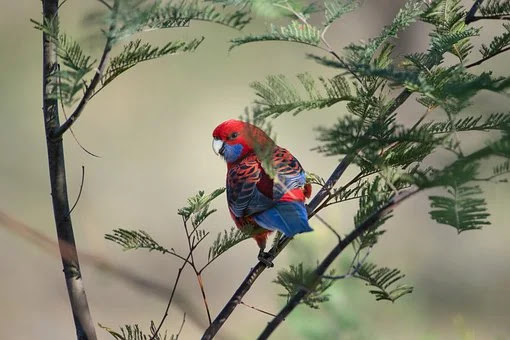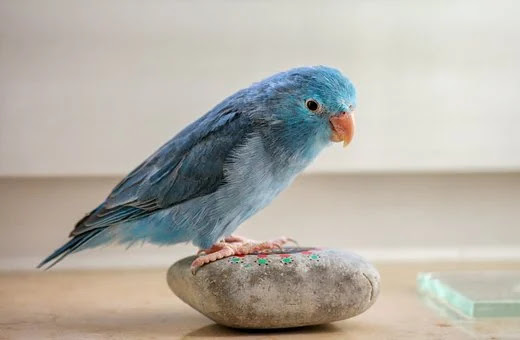The parrot is a very cute and beautiful bird. Its feathers are bright and colorful, which has a certain ornamental value. And the parrot is particularly interesting, because the parrot can learn from humans, and it is particularly interesting and cute when speaking. favorite. So everyone knows why parrots can talk? Which parrots can learn to talk?
Why do parrots talk
1. Good at imitating:
Parrots are good at imitating and have strong imitating power, so they can
imitate a variety of sounds or actions such as human speech, beasts and
whistles, which is why they have become common animal actors in circuses.
2. Developed vocal muscles:
The vocal organs of parrots have developed vocal muscles on the vocal
tube. The vocal muscles can vibrate rhythmically under the control of the
brain, which can produce a variety of complex sounds.
3. The tongue is special:
the tongue of a parrot has a special structure. Usually the tongue of a bird is
pointed, and the tongue of a parrot is round and the whole tongue is soft and
flexible, so it can make simple syllables.
What parrot can talk
1. Scarlet-breasted parrot:
The scarlet-breasted parrot is a medium-sized bird that belongs to the
Asian bird and can fly in a straight line. Its voice is loud and thick. It
can be trained to imitate human beings. If you usually feed it, you can use
nuts, grains, seeds, etc.
2. Grey parrots:
Grey
parrots are also known as African grey parrots. As the name suggests, they are
mainly distributed in Africa. It is a large parrot, likes to climb, and is
not good at flying. Because the grey parrot can communicate with humans
after being trained, it has become one of the most popular pet birds. If
you usually feed it, all kinds of seeds, nuts, fruits, nectar, berries, etc.
are enough.
3. Amazon parrots:
Amazon
parrots are very handsome in appearance. There are also different breeds,
but the ones that can be used as pets are those with green feathers and brown
beaks. Mainly distributed in the Amazon zone of Central America, South
America, and Mexico.
4. Sunflower parrots:
The
feathers of sunflower parrots are mainly white, and they are named sunflower
parrots because of the sunflower-like crest. Mainly distributed in
Australia. His personality is well-behaved and smart, and he will have feelings
after getting along with humans for a long time. Fresh fruits are good.
5. Macaws:
Macaws are
distributed in tropical regions of America. Their feathers are very bright and
beautiful. They are one of the largest parrots. There are also many
varieties, with 17 species in 6 genera. Among them, macaws have a very
long tail (the red parrots you see when you go to the zoo can see their long
tails.), and they are native to tropical rain forests.
How to train parrots to speak
One is to get close to
the parrot first, and then start teaching it when it has no fear.
The second is to keep the parrot in a spacious bird cage and give it plenty
of water and food. The sand in the bird cage should be changed frequently to
keep the cage clean and keep the bird healthy and happy.
The third is to be patient when training, and pay attention to the following
points:
1. Don't get too close to the bird cage. 2. The voice and tone of speech
should be clear and soft. Try to teach it in Mandarin. 3. Words and sentences
must be simple and clear. 4. Only teach one sentence at a time. After
discovering that it has started to learn and imitate, it can be taught
repeatedly until it is proficient. Before you are proficient, don't teach the
second sentence, otherwise it will be confused and your previous efforts will
be lost. 5. If it is found that a parrot does not pay attention to the sound,
but pays special attention to people, the person who teaches it should hide it
and teach it only by sound.
Once you master the above points, I think, your home will be skilled parrot
to say a few simple words
parrot Speech is well known. Of course, in addition to parrots, mynah and
starling can also learn human language. The bird that can learn human language
is first of all the kind that is good at imitating its bird's song, and it is
also good at calling itself, and secondly, it has a large mouth and a fleshy,
soft and short round tongue. In addition, it also has the characteristics of
docile temperament, easy to tame, and not shy.
1. Preparation before teaching
(1) Domestication:
Birds that are ready for teaching should choose young
birds with full feathers in the year. Old birds are generally not subject to
teaching due to their slow response. Before teaching, the birds should be able
to live a stable life in a cage or on a rack, not easily frightened, very tame,
and willing to approach people. A parrot must be tamed enough that a human hand
can touch its head or back, and it will not fly away without letting go of the
ankle chain. A parrot with this level of teaching has the best effect.
(2) Tongue twisting:
Among birds that can learn human language, starlings
need to twist their tongue to teach human language. Some use the method of
tongue trimming, using scissors to trim the tip of the tongue into a round
shape, but it is not effective and safe to twist the tongue. Parrots don’t
have to tame their tongues, they can teach human language after being tamed.
2. Teaching method
(1) Time:
Early morning is the best, because the bird's call is the most
active in the early morning, when the bird is not full, the teaching effect is
good.
(2) Environment:
Be quiet, without noise and conversation, otherwise it will
be easy to distract the bird, and it will also learn sounds that should not be
learned. Therefore, it is best to choose to teach in a quiet room.
(3) Content:
Choose simple short sentences at the beginning, such as
"Hello", "Welcome—Welcome", etc. The pronunciation of the
teaching should be clear, not vague, and the pronunciation should be slower and
not too hasty. You have to teach the same sentence to the bird repeatedly
every day, and there should be no change. For example, it will be better to
play with a tape recorder, and it will save effort. Generally speaking,
one sentence can be taught for about a week. After being able to learn a
sentence, consolidate it for a few days before teaching the second sentence.
For example, you can learn a set of sentences between March and April of the
following year. , Can also teach simple ballads.
During the teaching period, the bird cannot let it hear boring or
inappropriate statements. The language of the bird is very sensitive for a
short time, and it is easy to imitate the various sounds of the outside world
at this time. Once you find this sensitive period, you should catch it in
time and make good use of it!
Parrots are raised on the shelf. When teaching, when you talk to it, you will
shake the bird frame left and right, so that the bird will develop a
conditioned reflex to talk when it is shaking. After you have completed your
studies, you only need to push the bird frame gently, and the bird frame will
shake left and right. It is very interesting to be able to babble. The bird who
has been taught to speak human language should often tease its doctrine at
ordinary times. When it is doing doctrine, don't disturb it, avoid interrupting
its doctrine and affect the consolidation of performance.
How long does a parrot live
There are many species of parrots, with different life spans. The larger the size of the parrot, the longer the life span. Some time ago, there were many reports about Churchill’s pets, a grey parrot. This old bird is still alive when he is nearly a hundred years old. In general, small parrots, budgies and peony parrots have a lifespan of about 7-10 years, cockatiels have a lifespan of about 10-18 years, medium-sized parrots have an average lifespan of 20-50 years, and large parrots, macaws and sunflower parrots, both have lifespans. It is 50 years up.There are many species of parrots, with different life spans. The larger the size of the parrot, the longer the life span. Some time ago, there were many reports about Churchill’s pets, a grey parrot. This old bird is still alive when he is nearly a hundred years old. In general, small parrots, budgies and peony parrots have a lifespan of about 7-10 years, cockatiels have a lifespan of about 10-18 years, medium-sized parrots have an average lifespan of 20-50 years, and large parrots, macaws and sunflower parrots, both have lifespans. It is 50 years up.
As mentioned above, many
people think that parrots can talk, but it is not! There are many
varieties of parrots, and many of them can’t speak, so when you buy parrots,
you should also pay attention to choosing them.














0 Comments